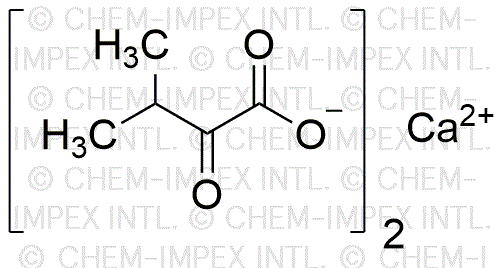Calcium 3-methyl-2-oxobutyrate is widely utilized in research focused on:
- Nutritional Supplements: This compound is often used in dietary supplements aimed at enhancing muscle recovery and performance, particularly for athletes and fitness enthusiasts.
- Food Industry: It serves as a food additive to improve flavor and stability in various food products, making it valuable for manufacturers looking to enhance product quality.
- Pharmaceuticals: The compound is explored for its potential therapeutic effects, particularly in formulations targeting metabolic disorders, offering a promising avenue for drug development.
- Agriculture: It is utilized in fertilizers to improve nutrient absorption in plants, which can lead to better crop yields and healthier produce.
- Biochemical Research: Researchers use it as a reagent in various biochemical assays, aiding in the study of metabolic pathways and enzyme activities.
Información general
Propiedades
Seguridad y normativas
Aplicaciones
Calcium 3-methyl-2-oxobutyrate is widely utilized in research focused on:
- Nutritional Supplements: This compound is often used in dietary supplements aimed at enhancing muscle recovery and performance, particularly for athletes and fitness enthusiasts.
- Food Industry: It serves as a food additive to improve flavor and stability in various food products, making it valuable for manufacturers looking to enhance product quality.
- Pharmaceuticals: The compound is explored for its potential therapeutic effects, particularly in formulations targeting metabolic disorders, offering a promising avenue for drug development.
- Agriculture: It is utilized in fertilizers to improve nutrient absorption in plants, which can lead to better crop yields and healthier produce.
- Biochemical Research: Researchers use it as a reagent in various biochemical assays, aiding in the study of metabolic pathways and enzyme activities.
Documentos
Hojas de datos de seguridad (HDS)
La SDS proporciona información de seguridad completa sobre la manipulación, el almacenamiento y la eliminación del producto.
Especificación del producto (PS)
La PS proporciona un desglose completo de las propiedades del producto, incluida la composición química, el estado físico, la pureza y los requisitos de almacenamiento. También detalla los rangos de calidad aceptables y las aplicaciones previstas del producto.
Certificados de análisis (COA)
Busque certificados de análisis (COA) ingresando el número de lote del producto. Los números de lote y de partida se pueden encontrar en la etiqueta de un producto después de las palabras "Lote" o "Lote".
Número de catálogo
Número de lote/lote
Certificados de origen (COO)
Este certificado de origen confirma el país en el que se fabricó el producto y también detalla los materiales y componentes utilizados en él y si se deriva de fuentes naturales, sintéticas u otras fuentes específicas. Este certificado puede ser necesario para cumplir con las normativas aduaneras, comerciales y regulatorias.
Número de catálogo
Número de lote/lote
Hojas de datos de seguridad (HDS)
La SDS proporciona información de seguridad completa sobre la manipulación, el almacenamiento y la eliminación del producto.
DownloadEspecificación del producto (PS)
La PS proporciona un desglose completo de las propiedades del producto, incluida la composición química, el estado físico, la pureza y los requisitos de almacenamiento. También detalla los rangos de calidad aceptables y las aplicaciones previstas del producto.
DownloadCertificados de análisis (COA)
Busque certificados de análisis (COA) ingresando el número de lote del producto. Los números de lote y de partida se pueden encontrar en la etiqueta de un producto después de las palabras "Lote" o "Lote".
Número de catálogo
Número de lote/lote
Certificados de origen (COO)
Este certificado de origen confirma el país en el que se fabricó el producto y también detalla los materiales y componentes utilizados en él y si se deriva de fuentes naturales, sintéticas u otras fuentes específicas. Este certificado puede ser necesario para cumplir con las normativas aduaneras, comerciales y regulatorias.


